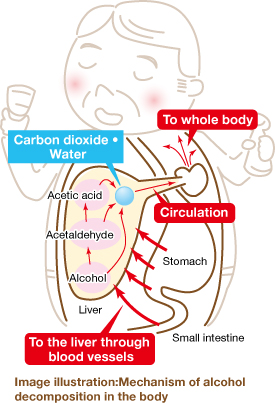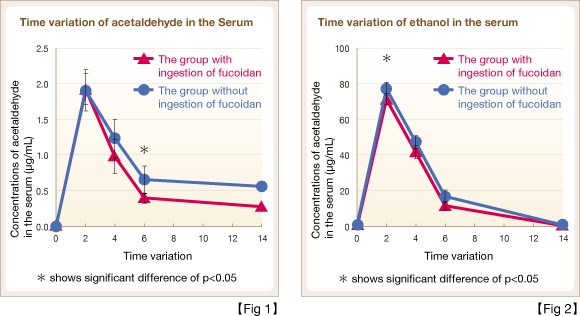The application of patent on "Agent for reducing acetaldehyde and ethanol" by Applicant, Marine Products Kimuraya, was publicized on July 8, 2010. 1)
The main claim was: "it was verified that ingestion of fucoidan before male and female adults took alcoholic drinks was effective in reducing the concentrations of acetaldehyde and ethanol in the breath and in the blood."
Verification of alcohol decomposition after ingestion of fucoidan
It is thought that one of the causative substances that makes one feel ill during or after drinking showing such symptoms as headaches and nausea, is acetaldehyde which is decomposed substance of ethanol.
We examined, by ingestion of fucoidan preliminarily, how these substances relate to drinking change.
10 subjects (20~60 years old) were conditioned to be hungry at the start of the tests. The subjects took the same lunch (without alcohol) on the first test day, and the test started after 6 hours.

30 minutes before the test, each subject ingested 30ml of fucoidan.
When the test started, each subject ingested 360ml of Sake (15% alcohol content) in 10 minutes.
Just before drinking (0 hour) and at each 2 hours, 4 hours, 6 hours, and 14 hours, 1 liter of breath and 20 ml blood was collected from each person.
2 hours after the beginning of the test, after taking samples of breath and blood, they took the same food (without alcohol).
As Control, the same subjects received an alcohol tolerance test some days later in the same manner as above, without ingestion of fucoidan before the test.
Concentrations of acetaldehyde and ethanol in the breath was measured by gas chromatography (GC) [1].
Acetaldehyde in serum was measured by the enzyme method [2], and concentration of ethanol, by a conventional method at an outside laboratory.
Verified that ingestion of fucoidan before drinking alcohol was effective
As a result, it was confirmed that by ingesting fucoidan, both concentrations of acetaldehyde and ethanol at each measurement time and at AUC (area under the blood concentration time curve, integrated value) were reduced.
It was particularly prominent that concentrations of acetaldehyde in the breath 4 hours after drinking and concentrations of ethanol in the breath 2 hours after drinking, showed significant differences [3] depending on whether fucoidan was ingested or not.
Also concentrations of acetaldehyde in the serum [4] 6 hours after drinking and concentrations of ethanol in the serum 2 hours after drinking, showed significant differences depending on whether fucoidan was ingested or not.

From these results it was shown that ingestion of fucoidan before drinking alcohol is effective on reducing the concentrations of acetaldehyde and ethanol in the breath and in the serum after drinking.
[Sources] 1)"Agent for reducing of acetaldehyde and ethanol", Published application for Patent 2010-150241 (2009).
- Glossary
-
[1]Gas chromatography (GC)/An instrumental analysis for vaporizable compounds. Measurement sensitivity is higher than liquid chromatography (LC).
[2]Enzyme method/An analysis method using degrading enzymes.
A quantitative analysis method of the blood using degrading enzymes of acetaldehyde.
Measurement method of degradation products by acetaldehyde dehydrogenase with the absorbance.[3]Significant difference/Term in Probability Theory and Statistics.
Stochastically, it is unlikely to be coincidental, likely to be objectively meaningful. This difference is called significant difference.[4]Serum/Supernatant after excluding cell components (red blood cells and white blood cells) and clotting components of clotted blood.
Light yellow liquid constituent including antibody, various nutrients and waste products.
Biochemical examinations of blood for components such as cholesterol and GOT can be carried out on the serum.
The blood clotting component is called blood clot.






